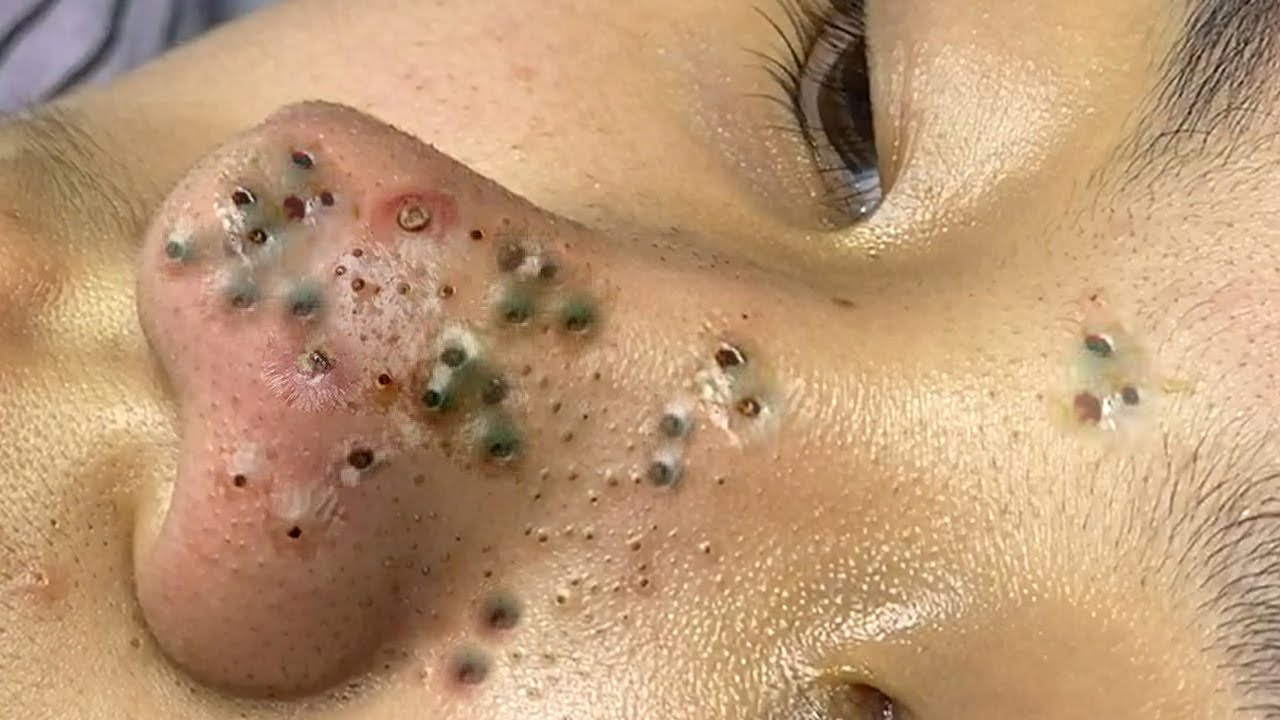Whiteheads vs. Blackheads: Causes, Treatments, and Tips (Video)
Whiteheads vs. Blackheads: Causes, Tips, and More
When managing breakouts, it’s key to know exactly what you’re dealing with. Whiteheads and blackheads can be stubborn, but you do have options. Ahead, discover exactly what blackheads and whiteheads are, how they form, how to manage them, and how best to care for your skin to help prevent these blemishes from cropping up.
Overview
Odds are that you’ve encountered at least one of two of the most common types of pimples: whiteheads and blackheads. These forms of congestion are very similar and are often fairly easy to identify because their names describe their appearance. However, if you’re wondering how to get rid of blackheads and whiteheads, you might be feeling stumped. Many are tempted to pick at their skin in the hopes of purging their pores, but that often makes the situation worse. Picking can cause blemishes to be more painful and more noticeable. In this guide, we break down better options for addressing blackheads and whiteheads.

Facts About Whiteheads and Blackheads
- Fact #1: Though whiteheads and blackheads look different, they both form when a pore has been blocked.
- Fact #2: Excess oil, dead skin cells, bacteria, and hormones can all play a role in the formation of blackheads and whiteheads. Stress, lifestyle choices, and certain beauty products may also contribute.
- Fact #3: There are over-the-counter and prescription options that can help address them, including products with salicylic acid.
- Fact #4: Making a few changes to your skincare routine can help prevent clogged pores.
Understanding Whiteheads vs. Blackheads
Whiteheads and blackheads are incredibly common—so much so that, according to the Cleveland Clinic some researchers suggest that nearly everyone is affected by these blemishes at one point or another in their lives.1,2 Interestingly enough, they’re also both formed by the same thing, a pore blockage. However, their appearance, contributing factors, and treatment options can differ.
What are whiteheads?
A whitehead is a type of blemish that manifests as a bump on the skin, also known as a comedone. They form when a pore is blocked by excess oil and dead skin cell buildup. Whiteheads are closed comedones, meaning “closed pore.” You can actually see the blockage within the pore underneath the skin, which looks like a white bump—hence the name. While they can form anywhere on the skin, they most frequently appear on the face (especially the nose, chin, and forehead), neck, back, chest, and upper arms.
What are blackheads?
Like whiteheads, blackheads are comedones, and form when a pore is blocked. However, blackheads look very different—almost like there is dirt stuck inside a pore. That’s because blackheads are open comedones, meaning the congestion has caused the opening of the pore to dilate, exposing the pore’s contents to the air. A chemical reaction between the air and the contents of the pore causes it to turn dark, which is why these blemishes are called “blackheads.” Blackheads can also form anywhere on the skin, but tend to pop up on the face, particularly the nose and chin, as well as the neck, back, and chest.
What Causes Whiteheads and Blackheads?
All pimples, including blackheads and whiteheads, ultimately are caused by the same thing: pore congestion. There are a variety of materials that can block the pore and lead to whiteheads and blackheads, and certain factors can also exacerbate these breakouts and make them worse.

Common causes
- Excess oil production: Those with whiteheads, blackheads, and pimples tend to have skin that produces too much oil, or sebum. When excess oil mixes with dead skin cells, pores can become clogged. Those clogs can turn into blemishes, including whiteheads and blackheads.
- Dead skin cells: As mentioned, the combination of dead skin cells with excess sebum can congest pores. The two blend together, creating a substance that plugs up the pore.
- Bacteria: In some cases, bacteria, specifically Propionibacterium acnes, can contribute to the formation of blackheads and whiteheads. Because whiteheads are closed comedones, it is easier for bacteria to proliferate, which can make them more susceptible to inflammation.
- Hormonal changes: Fluctuations in hormone levels can cause your skin to produce excess oil, one of the primary causes of blackheads and whiteheads.
Contributing factors
- Stress: When stress levels increase, pores can become even more clogged.
- Lifestyle factors: According to the American Academy of Dermatology (AAD), failure to get enough sleep can contribute to the formation of blemishes.3
- Skincare, haircare, and cosmetic products: A variety of beauty products can lead to clogged pores. For example, haircare formulas like conditioner and styling pomades can trigger the formation of whiteheads. Ingredients in hair, makeup, and even skincare products can be comedogenic, meaning they can clog pores. This is why using formulas that are non-comedogenic is such an important aspect of promoting and maintaining clearer skin.
How To Manage Whiteheads and Blackheads
There are numerous simple, over-the-counter ways to target breakouts at home, as well as prescription options.
Keep in mind, if you’re dealing with stubborn whiteheads and blackheads, the best course of action is to see a dermatologist. They’ll be able to assess your unique skin concerns and create a customized plan to address your blemishes.
Below, we’re breaking down some of the different ways you can reduce the appearance of whiteheads and blackheads. But first, one thing not to do: Never attempt blackhead and whitehead removal at home. Picking your pimples can increase your risk of scarring.
Over-the-counter options
In many cases, you can help manage whiteheads and blackheads by using products you can buy at your local drugstore or supermarket. Certain active ingredients can be especially helpful in caring for blemish-prone skin.
Cleansers and exfoliators
One of the most effective ways to address whiteheads and blackheads is by combatting the excess oil and dead skin cells that so commonly cause them to form. Of course, face washes are designed to remove excess oil from the skin, while exfoliators slough away dead skin cells. Combining both into one step can make for a powerful solution. We suggest CeraVe Acne Control Cleanser, which contains salicylic acid, an ingredient recommended by the AAD for managing whiteheads and blackheads.4 The formula, which also contains kaolin clay, three essential ceramides, and niacinamide, helps improve the appearance of pores. It also features salicylic acid to clear acne and reduce blackheads.
Topical creams and gels
If you want a more targeted option, look for a spot treatment, cream, or gel. Rather than using it on your whole face, these products are applied solely to the areas where you’ve developed whiteheads and blackheads. However, be aware that some formulas in this category may leave the skin feeling stripped. We recommend CeraVe Acne Control Gel, which helps clear acne without drying out your skin.
CeraVe Tip: If your whiteheads and blackheads go away but leave dark spots in their wake, you can use a different kind of targeted formula to help reduce their appearance. CeraVe Resurfacing Retinol Serum helps refine and resurface skin, reducing the appearance of post-acne marks and visible pores.
Prescription treatments
If your blackheads and whiteheads do not respond to products you’ve purchased over the counter, you may want to consider seeing your dermatologist for a prescription-strength option.
Retinoids
In addition to over-the-counter retinol products, you can get stronger versions from your doctor, like tretinoin and isotretinoin. They’re all from a class of ingredients known as retinoids. While some retinoids are gentler, some are extremely powerful and are only meant to be used to address severe acne. Talk to your dermatologist to see if a prescription-strength retinoid is right for you.
Antibiotics
In some cases, a healthcare provider may prescribe antibiotics to address whiteheads, blackheads, and other forms of acne. Depending on the unique medication prescribed, antibiotics for whiteheads and blackheads can be applied topically or taken orally.
Hormonal treatments
Oral contraceptives have been shown to be effective in treating blackheads, whiteheads, and other blemishes. In fact, there are some oral contraceptive options that have been approved by the FDA to treat blemishes. However, not everyone should use oral contraceptives; talk to your healthcare provider to see if one of these medications is right for you.
Prevention Tips for Whiteheads and Blackheads
If you’re hoping to learn how to fix blackheads and whiteheads permanently, unfortunately, there’s no guarantee that you can get rid of them entirely. With that said, you can take steps to help prevent them and maintain clearer-looking skin.
Daily skincare routine
It’s time to start a consistent skincare routine and stick with it. Look for brands that are trusted by experts and offer products that feature active ingredients known to support the skin. All CeraVe products are developed with dermatologists using carefully-selected and science-backed ingredients. This includes CeraVe’s signature blend of ceramides, a type of lipid that naturally occurs in the skin. Low ceramide levels have been linked to a variety of skin conditions, including blemishes and skin congestion.
Though social media may have you thinking otherwise, your skincare routine doesn’t actually need to be complicated to work. Start by using a cleanser, moisturizer, and sunscreen, then add in any treatment products as needed. You can actually combine your moisturizing and sunscreen steps into one with a product like CeraVe AM Facial Moisturizing Lotion SPF 30, then use a richer moisturizer in the evening to nourish your skin while you sleep, such as CeraVe PM Facial Moisturizing Lotion.
Proper cleansing techniques
Leaving excess oil, dead skin cells, and grime on the surface of your skin can all contribute to clogged pores. This makes cleansing essential if you want to promote visibly clearer, more even-looking skin. Try the CeraVe Foaming Facial Cleanser, which deeply cleanses and removes excess oil without disrupting the skin barrier.
Beyond simply using a cleanser, make sure you cleanse the correct way. You want to be gentle (no harsh scrubbing or rubbing) and use lukewarm water—hot water can dry out your skin.
Effective ingredients
Using products with the right ingredients can make all the difference. One effective ingredient that you’ll find in CeraVe formulas is niacinamide, a form of vitamin B. It can help with congested pores as studies show that it can help balance excess oiliness, which is one of the causes of blackheads and whiteheads.5 Additionally, niacinamide can help calm the appearance of redness (something often associated with blemish-prone skin).
Importance of non-comedogenic products
Remember how “comedone” means “clogged pore?” When you see the label “non-comedogenic” on a skincare product, that means that particular item won’t clog your pores. Looking for non-comedogenic products can be beneficial for everyone, but especially those with blemish-prone skin. If you aren’t sure where to start, all CeraVe acne products are non-comedogenic.
For help choosing the right products for your specific skin type and skin concerns, use our Find My Skincare Solution tool.

